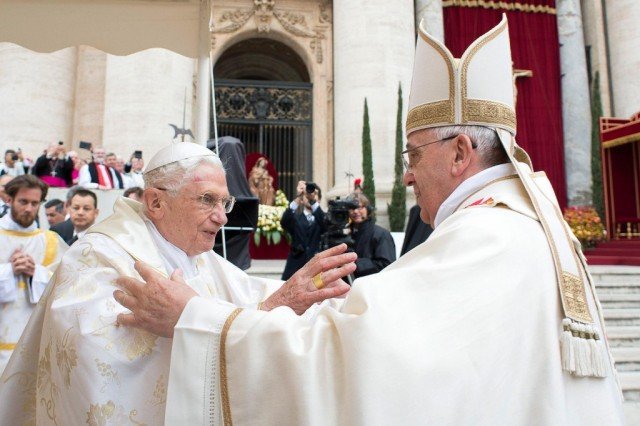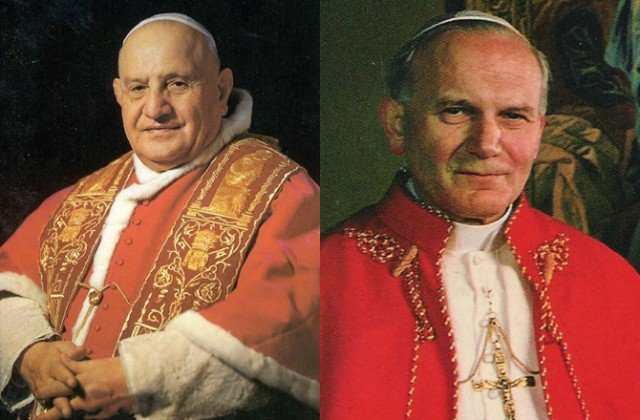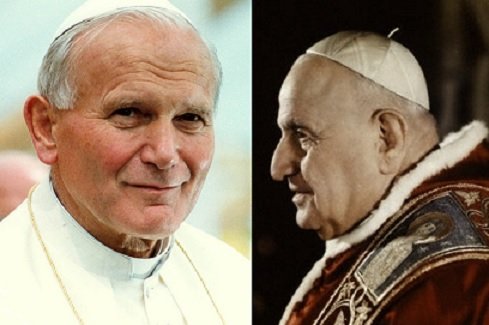Home Tags Posts tagged with "pope john xxiii"
pope john xxiii
Pope Francis has declared Popes John Paul II and John XXIII saints in a ceremony attended by hundreds of thousands of people in St. Peter Square.
Pope Francis praised his two predecessors as “men of courage” at the Vatican service, the first time in history that two popes have been canonized at the same time.
The Mass was attended by Pope Emeritus Benedict, who quit as pope last year, and roughly 100 foreign delegations.
Analysts say Pope Francis is trying to balance the conservative legacy of John Paul with the reforming zeal of John.

Pope Emeritus Benedict XVI and Pope Francis during Mass before the canonization ceremony of Popes John XXIII and John Paul II
At the climax of the service, Pope Francis said in Latin: “We declare and define Blessed John XXIII and John Paul II to be saints and we enroll them among the saints, decreeing that they are to be venerated as such by the whole Church.”
Relics of each man – a container of blood from John Paul and a piece of skin from John – were placed near the altar.
Pope Francis paid tribute to the two new saints as “priests, bishops and popes of the 20th Century”.
“They lived through the tragic events of that century, but they were not overwhelmed by them. For them, God was more powerful,” he said.
The Vatican estimated some 800,000 pilgrims had poured into Rome to see the two-hour ceremony first-hand.
For those unable to make it into St Peter’s Square, giant screens were set up in nearby streets and elsewhere in the city.
[youtube QxwlQSrmIwM 650]
Pope John Paul II and Pope John XXIII’s canonization is bringing attention to the complex process of becoming a saint, a highly regulated series of steps that can seem quite mysterious to those who are not devout Roman Catholics.
How many saints are there?
It’s hard to pin down an exact number, but more than you might think. In the old days – as in the first thousand years of the church’s history – saints were created by popular demand.
St. Ulrich of Augsburg was the first to be canonized by a pope, in 993, and the Vatican eventually took over and formalized the process.
The Vatican’s Roman Martyrology says some 7,000 people have been canonized or beatified (an earlier step), but some scholars believe the total number of saints is more like 10,000.
Is it easier or harder to become a saint now?
The raw numbers would suggest it’s easier, though they don’t tell the entire story.
Pope Francis, who has been pontiff for just over a year, has already canonized 817 men and women, but 813 of them were martyrs from a single group of Italians who were beheaded by Ottoman Turks in the 15th Century.

Pope John Paul II and Pope John XXIII’s canonization is bringing attention to the complex process of becoming a saint
John Paul II canonized 482 during the quarter-century he presided over the church, but more than 400 of those were from groups of martyrs, according to the Catholic World Report.
By contrast, Pope Benedict XVI added 45 saints during his pontificate.
Does every pope become a saint?
Yet, only about a third of all popes are saints, and it’s getting harder to make the leap the from St. Peter’s throne to sainthood, according to the Pew Research Center.
Fifty-two of the first 55 popes got the nod but that pace has slowed dramatically. Only five popes have become saints in the last 1,000 years, although that will now shoot up to seven. Four more popes who died between 1878 and 1978 are in the pipeline – Pius IX, Pius XII, Paul VI, and John Paul I – but John Paul II leapfrogged ahead of them.
Can sainthood be revoked?
Canonization is permanent but some saints have been, for lack of a better term, demoted – by being dropped from the Vatican’s list of official feast days, sometimes because of questions about whether they actually existed.
One notable example is Saint Philomena, who was recognized in 1835 after a tomb with a remains of a teenage girl was found in the Roman catacombs with the inscription “Filumena” and a symbol of martydom, according to the Times of London.
The Vatican suppressed her cult in 1960 after experts decided there was no evidence linking the bones in the tomb to the legend of a martyred Greek princess.
Saint Christopher, the patron of travelers, lost his standing in 1969 – although not his popular cachet if the number of medals hanging from rear-view mirrors in cars is any indication. St. George, the patron of warriors, was also bumped down that year but restored in 2001 without explanation.
Where can I find a list of all the saints?
The compendiums that exist are extensive, but not necessarily exhaustive. And you might want to brush up on your Latin.
The Vatican’s Congregation for the Causes of Saints, the bureaucratic arm of the church that shepherds candidates through the complex steps, published the Index ac Status Causarum in 1998 with the names of the blesseds and saints – but only for the previous 400 years.
An oft-cited reference is Butler’s Lives of the Saints, but that was written in the mid-18th century and only contains 2,500 biographies in its latest revision.
Then there is the Acta Santorum, an index based on feast days that has 68 volumes, the first of which was published in 1643. A cluster of scholarly Jesuit priests in Brussels, the Bollandists, is toiling to complete it in chronological order, using church records and old texts in myriad languages to verify that the saints deserve veneration.
Pope John Paul II and Pope John XXIII are to be declared saints at an unprecedented open-air ceremony in Rome on Sunday.
A Mass co-celebrated by Pope Francis and his predecessor, Pope Emeritus Benedict, will be witnessed by one million pilgrims and a vast TV and radio audience.
Nearly 100 foreign delegations are due, including royal dignitaries and heads of state and government.
It is the first time two popes have been canonized at the same time.
Correspondents say the move is being seen as an attempt to unite conservative and reformist camps within the Roman Catholic Church.

Pope John Paul II and Pope John XXIII are to be declared saints at an unprecedented open-air ceremony in Rome
Pilgrims have been pouring into Rome and special bus, train and boat services ferried many more into the city early on Sunday morning for the two-hour ceremony which starts at 10:00 local.
Some had bagged places to sleep overnight as close as possible to St Peter’s Square, hoping to be among the first in when it opens to the public.
Giant screens have also been erected in nearby streets and elsewhere in the city for those unable to get into the square.
The Vatican confirmed on Saturday that 87-year-old Pope Emeritus Benedict XVI would make a rare public appearance alongside his successor, Pope Francis.
“He will co-celebrate, which does not mean he will go to the altar,” a Vatican spokesman said.
“We will all be happy to have him there.”
Benedict XVI became the first pope to resign for 600 years when he quit for health reasons a year ago, sending shock waves around the world.
The process of saint-making is usually long and very costly.
However, John Paul II, whose 26-year reign ended in 2005, has been fast-tracked to sainthood in just nine years.
Many among the huge crowds that gathered as he lay dying cried out “Santo subito!” (Make him a saint immediately!).
By contrast Italian-born John XXIII, known as the Good Pope after his 1958-1963 papacy, had his promotion to full sainthood decided suddenly and very recently by Pope Francis.
By canonizing both John XXIII – the pope who set off the reform movement – and John Paul II – the pope who applied the brakes – Pope Francis has skillfully deflected any possible criticism that he could be taking sides.
[youtube tdCx0oB-CLo 650]
Pope Francis has announced that Pope John Paul II and Pope John XXIII will be declared saints on April 27, 2014.
The pontiff said in July that he would canonize his two predecessors, after approving a second miracle attributed to John Paul.
Polish John Paul, the first non-Italian pope for more than 400 years, led the Catholic Church from 1978 to 2005.

Pope John Paul II and Pope John XXIII will be declared saints on April 27, 2014
Pope John XXIII was pontiff from 1958 to 1963, calling the Second Vatican Council that transformed the Church.
The decision to canonize the two popes at the same time appears designed to unify Catholics, correspondents say.
Pope John Paul II is a favorite of conservative Catholics, while Pope John XXIII is widely admired by the Church’s progressive wing.
John Paul stood out for his media-friendly, globetrotting style. He was a fierce critic of both communism and what he saw as the excesses of capitalism.
Pope John is remembered for introducing the vernacular to replace Latin in church masses and for creating warmer ties between the Catholic Church and the Jewish faith.
Pope John XXIII has a big following in Italy, where he is known as Il Papa Buono, the good pope.
[youtube KszLw5r9LbA]
John Paul II could be declared a saint this year after a Vatican committee approved a second miracle attributed to the former pope’s intercession.
The Congregation for the Causes of Saints ruled an “inexplicable recovery” on 1 May 2011 was due to the late Pope’s intercession, Ansa reported.
Earlier that same day he had been beatified after a first miracle was attributed to his intervention.
Pope Francis must now give his approval before a canonization date is set.
Canonization is the final step in the official process that declares a deceased person to be a saint.
At a plenary meeting of the Congregation on Tuesday, cardinals and bishops mooted a canonization ceremony taking place in December, sources told Ansa.
One possible date would be 8 December, on which Catholics celebrate the feast of the Immaculate Conception, which this year falls on a Sunday.
John Paul II could be canonized at the same time as John XXIII, Vatican sources suggested. Venerated by Catholics as “the good pope”, John XXIII was elected in 1958 and convened the Second Vatican Council in 1962, but died the following year before it was finished.

John Paul II could be declared a saint this year after a Vatican committee approved a second miracle attributed to him
Canonization requires the attribution of one further miracle to the intercession of the candidate after they have been beatified.
The Vatican has not revealed details about the second miracle in John Paul II’s case.
It was reportedly deemed an “inexplicable recovery” by a panel of doctors before being approved last month by a board of the Congregation for the Causes of Saints’ theologians.
John Paul II died in 2005 aged 84 and was beatified by his successor Benedict XVI in May 2011.
Among a crowd hundreds of thousands strong on St Peter’s Square was French nun Marie Simon-Pierre, who says she was cured of Parkinson’s Disease after praying for the intervention of the late pope little more than a month after he died.
Some questioned the Church’s speed in beatifying John Paul II just six years after his death.
Although widely regarded as one of the great popes of modern times, his 26-year pontificate was tarnished by his handling of the clerical sex abuse scandal that has rocked the global Church.
Critics say other of the Church’s deep-seated problems – such as its dysfunctional management and financial scandals at the Vatican bank – stem from shortcomings of his pontificate.
John Paul II reformed the sainthood process in 1983, making it faster, simpler, and cheaper. The office of “Devil’s advocate” – an official whose job was to try to knock down the case for sainthood – was eliminated, and the required number of miracles was dropped.
The idea was to lift up contemporary role models of holiness in order to convince a jaded secular world that sanctity is alive in the here and now, says veteran Vatican analyst John Allen.
The result was that John Paul II beatified and canonized more people than all previous popes combined.
[youtube 8-QZOusagZc]





